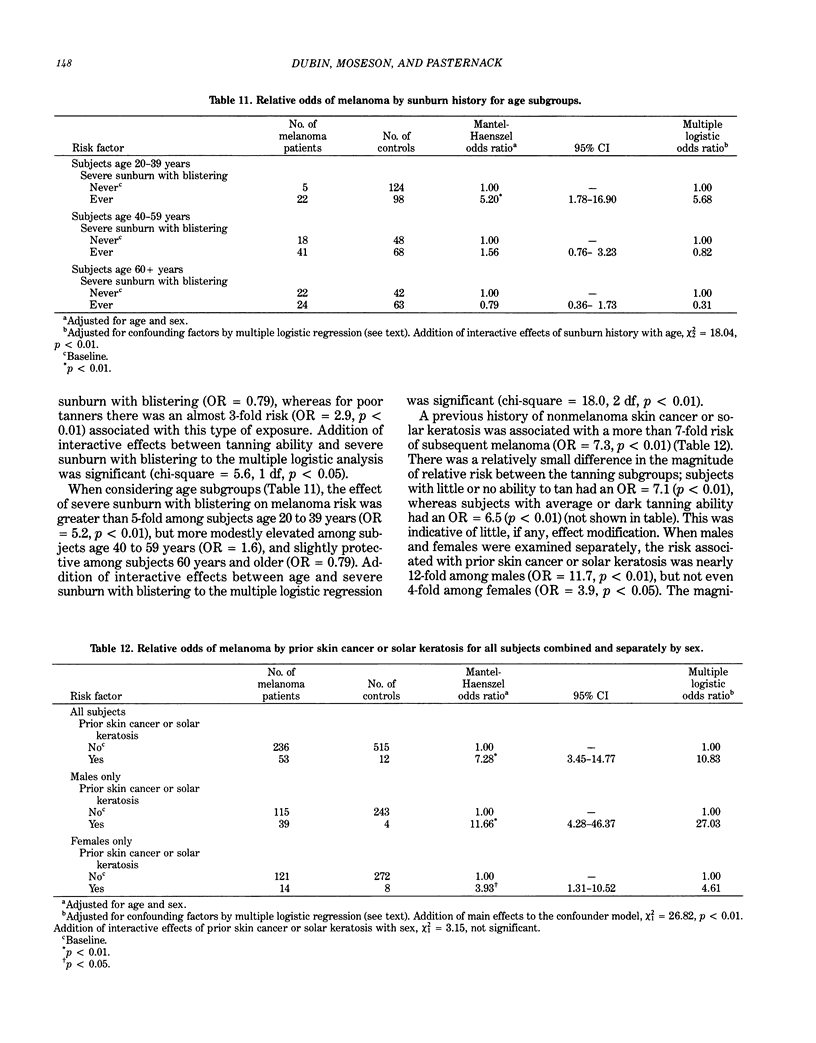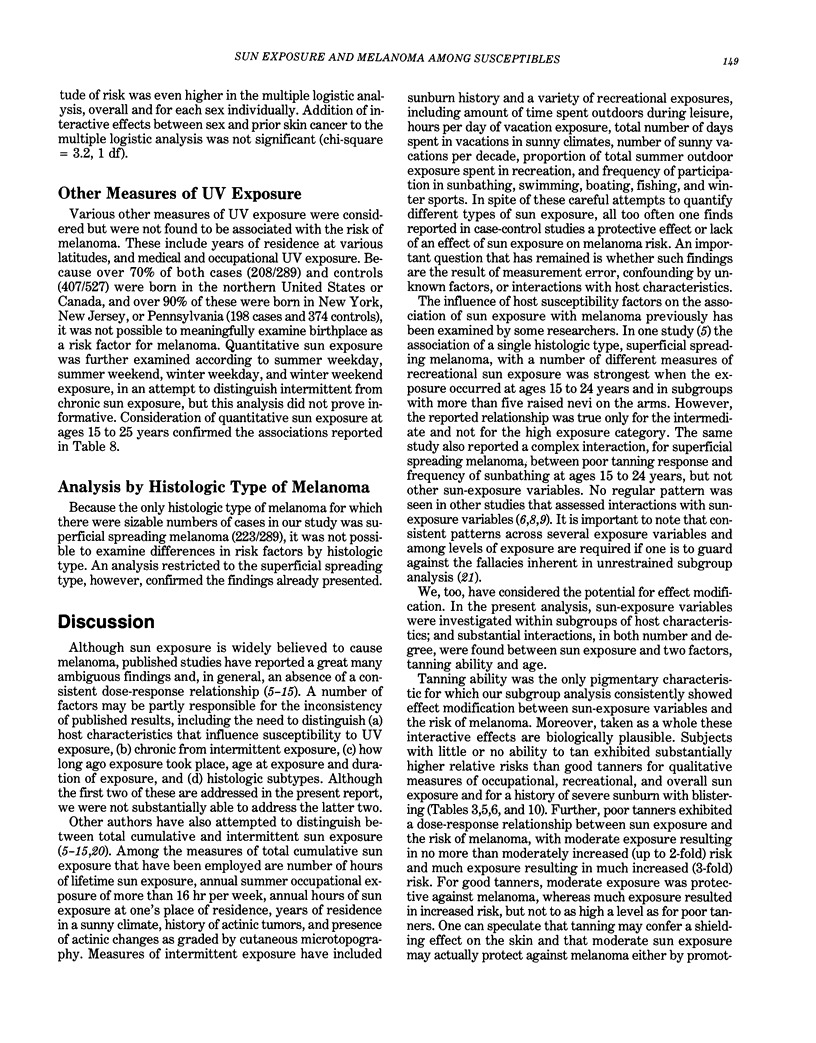Abstract
The purpose of this case-control study was to identify susceptible subgroups, primarily based on pigmentary characteristics, at higher risk of developing melanoma when exposed to the sun. The study group, which was interviewed from 1979 to 1982, consisted of 289 consecutive patients with melanoma and 527 randomly selected controls without cancer. In general, the risk of melanoma associated with sun exposure was greater for individuals expected to be susceptible on the basis of poor ability to tan, but not other pigmentary traits. There were, in addition, some noteworthy interactions between age and sun exposure. Among subjects with poor tanning ability, the risk of melanoma associated with outdoor occupation was more than 3-fold [odds ratio (OR) = 3.3] compared to indoor occupation. In contrast, the analogous OR was much less elevated among subjects with a good ability to tan (OR = 1.5). Mixed indoor and outdoor job exposure was protective among good tanners (OR = 0.80), but not among poor tanners (OR = 1.5). A similar pattern was seen for recreational sun exposure and, when applying multiple logistic regression, for the patient's overall subjective assessment of his lifetime sun exposure. However, quantitative assessment of average hours of sun exposure did not prove to be a good indicator of melanoma risk, even among susceptible individuals. A history of severe sunburn with blistering was associated with nearly 3-fold risk among poor tanners (OR = 2.9) but was protective among good tanners (OR = 0.79). A history of nonmelanoma skin cancer or solar keratosis was a very strong risk factor (OR = 7.3), which, however, did not significantly differ in magnitude among susceptibility subgroups.
Full text
PDF












Selected References
These references are in PubMed. This may not be the complete list of references from this article.
- Dubin N., Moseson M., Pasternack B. S. Epidemiology of malignant melanoma: pigmentary traits, ultraviolet radiation, and the identification of high-risk populations. Recent Results Cancer Res. 1986;102:56–75. doi: 10.1007/978-3-642-82641-2_5. [DOI] [PubMed] [Google Scholar]
- Elwood J. M., Gallagher R. P., Hill G. B., Pearson J. C. Cutaneous melanoma in relation to intermittent and constant sun exposure--the Western Canada Melanoma Study. Int J Cancer. 1985 Apr 15;35(4):427–433. doi: 10.1002/ijc.2910350403. [DOI] [PubMed] [Google Scholar]
- Elwood J. M., Hislop T. G. Solar radiation in the etiology of cutaneous malignant melanoma in Caucasians. Natl Cancer Inst Monogr. 1982;62:167–171. [PubMed] [Google Scholar]
- Graham S., Marshall J., Haughey B., Stoll H., Zielezny M., Brasure J., West D. An inquiry into the epidemiology of melanoma. Am J Epidemiol. 1985 Oct;122(4):606–619. doi: 10.1093/oxfordjournals.aje.a114140. [DOI] [PubMed] [Google Scholar]
- Green A. C., O'Rourke M. G. Cutaneous malignant melanoma in association with other skin cancers. J Natl Cancer Inst. 1985 May;74(5):977–980. [PubMed] [Google Scholar]
- Green A., Siskind V., Bain C., Alexander J. Sunburn and malignant melanoma. Br J Cancer. 1985 Mar;51(3):393–397. doi: 10.1038/bjc.1985.53. [DOI] [PMC free article] [PubMed] [Google Scholar]
- Holman C. D., Armstrong B. K. Cutaneous malignant melanoma and indicators of total accumulated exposure to the sun: an analysis separating histogenetic types. J Natl Cancer Inst. 1984 Jul;73(1):75–82. [PubMed] [Google Scholar]
- Holman C. D., Armstrong B. K., Evans P. R., Lumsden G. J., Dallimore K. J., Meehan C. J., Beagley J., Gibson I. M. Relationship of solar keratosis and history of skin cancer to objective measures of actinic skin damage. Br J Dermatol. 1984 Feb;110(2):129–138. doi: 10.1111/j.1365-2133.1984.tb07458.x. [DOI] [PubMed] [Google Scholar]
- Holman C. D., Armstrong B. K., Heenan P. J. Relationship of cutaneous malignant melanoma to individual sunlight-exposure habits. J Natl Cancer Inst. 1986 Mar;76(3):403–414. [PubMed] [Google Scholar]
- Klepp O., Magnus K. Some environmental and bodily characteristics of melanoma patients. A case-control study. Int J Cancer. 1979 Apr 15;23(4):482–486. doi: 10.1002/ijc.2910230407. [DOI] [PubMed] [Google Scholar]
- Lee J. A. Melanoma and exposure to sunlight. Epidemiol Rev. 1982;4:110–136. doi: 10.1093/oxfordjournals.epirev.a036243. [DOI] [PubMed] [Google Scholar]
- Lew R. A., Sober A. J., Cook N., Marvell R., Fitzpatrick T. B. Sun exposure habits in patients with cutaneous melanoma: a case control study. J Dermatol Surg Oncol. 1983 Dec;9(12):981–986. doi: 10.1111/j.1524-4725.1983.tb01051.x. [DOI] [PubMed] [Google Scholar]
- MANTEL N., HAENSZEL W. Statistical aspects of the analysis of data from retrospective studies of disease. J Natl Cancer Inst. 1959 Apr;22(4):719–748. [PubMed] [Google Scholar]
- MacKie R. M., Aitchison T. Severe sunburn and subsequent risk of primary cutaneous malignant melanoma in scotland. Br J Cancer. 1982 Dec;46(6):955–960. doi: 10.1038/bjc.1982.307. [DOI] [PMC free article] [PubMed] [Google Scholar]
- Pearl D. K., Scott E. L. The anatomical distribution of skin cancers. Int J Epidemiol. 1986 Dec;15(4):502–506. doi: 10.1093/ije/15.4.502. [DOI] [PubMed] [Google Scholar]
- Sorahan T., Grimley R. P. The aetiological significance of sunlight and fluorescent lighting in malignant melanoma: a case-control study. Br J Cancer. 1985 Nov;52(5):765–769. doi: 10.1038/bjc.1985.255. [DOI] [PMC free article] [PubMed] [Google Scholar]
- Stallones R. A. The use and abuse of subgroup analysis in epidemiological research. Prev Med. 1987 Mar;16(2):183–194. doi: 10.1016/0091-7435(87)90082-x. [DOI] [PubMed] [Google Scholar]


